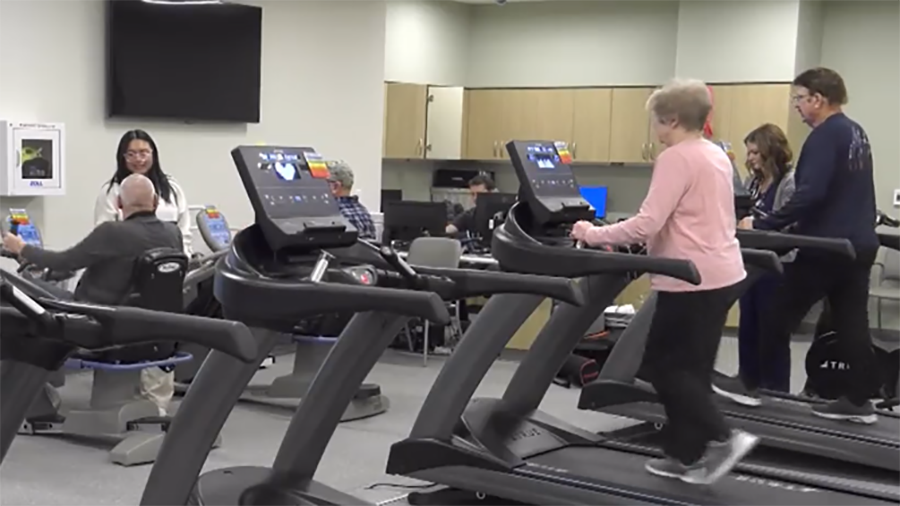Utah Man Survives Stroke, Urges Others To Know The Signs
May 27, 2021, 10:49 PM | Updated: Apr 14, 2023, 2:40 pm
SALT LAKE CITY — Only about 40% of Americans can identify all five major symptoms of a stroke — a scary figure when quick treatment is critical for recovery. A 45-year-old Utah man said he’s grateful his wife knew the signs when he suffered an ischemic stroke in February.
On Feb. 3, 2021, David Lamb woke up early to hit the gym.
“I got up to go to the gym, put on my shorts and was crouched down and fell on my butt,” he said.
When his wife, Mollee Lamb, noticed he had fallen over a couple of times, she grew concerned, but after checking him over, “I got him back to bed thinking it was a migraine,” Mollee said.
He could still move his fingers, arms and legs.
When he woke up a couple of hours later, David said he was off-balance, dizzy, and his left arm and leg felt heavy.
“It just felt like a 20-pound bag of sand on one side of my body,” he described. “It just felt weird. I had no coordination over there.”
“I said, ‘Oh, we’re going to the hospital. That’s definitely a sign of stroke,'” said Mollee.
His wife got him to the hospital to receive IV medication within 90 minutes.
“It was within the window where he could have the clot-busting shot,” she said, which is key in preventing brain loss.
“(The tPA IV medication) is something that helps dissolve that clot and helps restore the blood flow to the effective part of the brain, so the sooner you get that, the better off you are,” David Lamb explained.
Dr. Megan Donohue, a neurologist with Intermountain Healthcare, said when it comes to stroke, time is brain.
“There’s some estimates that we lose 32,000 neurons every second that we delay,” she said.
She uses the acronym BE FAST as a guideline for the signs of stroke.
- B: Balance — sudden dizziness or loss of balance or coordination
- E: Eyes — sudden trouble seeing in one or both eyes
- F: Face — sudden weakness of the face (Does one side of your face droop?)
- A: Arm — weakness of an arm or leg
- S: Speech — sudden difficulty speaking
- T: Time — time the symptoms started
Donohue said if someone is experiencing even just one of these symptoms, it’s time to call 911 or go immediately to the hospital.
By delaying care, Donohue said patients might not have as many treatment options available, risking irreversible brain damage and permanent disability.
“It could be anywhere from cognitive changes, to speech disturbances, to weakness or numbness on half your body for the rest of your life,” she explained.
Donohue said they can administer IV medications within the first 4.5 hours of symptom onset and can remove a clot within 24 hours after a large vessel has been blocked, but the sooner doctors intervene, the better chance for recovery.
David Lamb, a 45-year-old marathon runner, was in great shape.
“I would bike for an hour in the afternoons. I would go lift weights five times a week. I had just bench-pressed 250,” he said.
“We see people in their 30s, 40s, and even 50s, in denial about having a stroke and delaying the call to 911, or just thinking that the symptoms will go away,” Donohue said. “It could happen to anyone at any time.”
Now, Lamb is starting over with physical, occupational and speech therapy.
“I have to learn how to move my leg. It’s sort of annoying — I have to think about how to walk,” he said.
He’s back to riding his indoor bike and doing pool therapy to help him regain function in his leg.
“You need to get your heart rate up, you need to get that blood flow going to your brain so that your brain relearns or reaccesses parts,” he explained.
In addition to physical recovery, Lamb’s brain is also healing.
“Some of my impacts have been my executive functioning, scheduling, really managing my day — so that’s been something where I’ve had to get like a Franklin planner-type thing, where I go and write down what I’m going to be doing all day, where I’m going,” he said.
Even though recovery is difficult, Lamb said he’s grateful they acted quickly enough to avoid or reduce the long-term implications so he can enjoy life with his wife and their three young kids.
Mollee Lamb recalled one of the most difficult moments when she was first in the hospital with David.
“I was really contemplating, ‘What does this mean for our family?’ (The) worst-case scenario is going through my head,” she said. “I leaned over him and held him on the bed and told him that we could we could make it through — whatever happened, we could make it through. And then he teased me and started laughing hysterically, and I knew at that point, his personality was intact and we would be fine.”
David hasn’t lost his sense of humor or infectious laugh and isn’t taking anything for granted.
“I think it’s valuing each day, valuing each opportunity with them,” he said. “I can go on the hikes, I can go swimming with them, I can have that fun with them, and I have to pay my dues now to do that over the long term.”
“It’s been truly inspiring to watch his recovery,” Mollee Lamb said.
David plans to run a 5K in August, marking six months after his stroke.
Mollee urged others to become familiar with the symptoms of stroke. She said being educated is the key to long-term wellbeing.
“I don’t know how many stroke victims realize in the moment that they’re having a stroke because it’s new and different,” Mollee said. “So it’s really important for family members to be aware of family history and what are the signs and symptoms of stroke.”
Both of David’s parents have also suffered from a stroke.
Donohue said other risk factors include high blood pressure, high cholesterol, smoking and obesity.
“Know the signs and symptoms of stroke, know your own risk factors, and then as soon as you notice the symptoms come up, call 911,” Donohue said.
Intermountain Healthcare noticed a decline in patients seeking care for a stroke during the pandemic in fear of getting COVID-19. Doctors assured people the hospital is a safe place to receive care.























